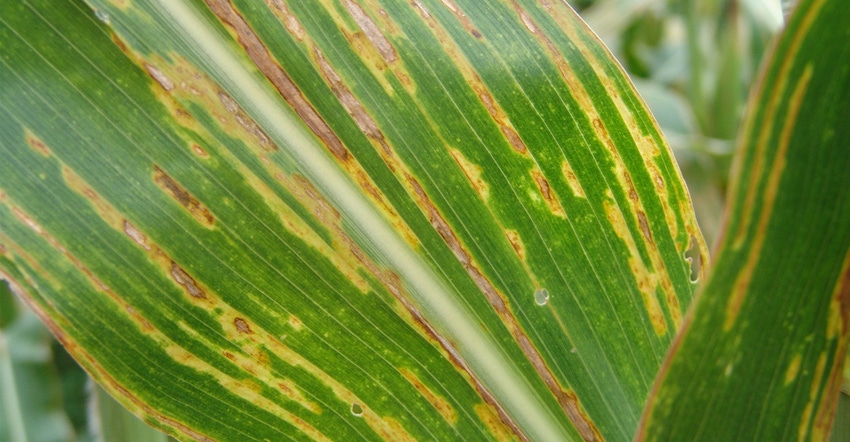
In June, bacterial leaf streak, a bacterial disease only recently confirmed in corn in the United States and Nebraska in 2016, was confirmed in cornfields in York, Dawson, Holt, Perkins and Hamilton counties.
As a fairly new disease to Nebraska, there isn't much that's known about bacterial leaf streak at this point, including how much it affects yield.
However, over the last two years, researchers at the University of Nebraska-Lincoln have learned some new things about BLS. Here's a quick recap on six things to know about bacterial leaf streak:
1. It's been confirmed in 60 Nebraska counties since 2016. While Nebraska was the first state in the U.S. it's been confirmed in, it's also been confirmed in surrounding states like Kansas, Colorado, Iowa and South Dakota, as well as Texas, Oklahoma, Minnesota and Illinois.
While it's still a fairly new disease to Nebraska, growers are becoming more familiar with its symptoms, especially in fields where it's shown up in previous years. "It's appeared suddenly and is off to a quick start. People in northern, west-central and south-central Nebraska in mid-June reported they were starting to see it show up, and often in the same fields they've seen it in the past," says Tamra Jackson-Ziems, Nebraska Extension plant pathologist.
2. Wet conditions are favorable. While all the contributing factors aren't yet known, it is understood that wet conditions are favorable, like many other bacterial diseases.
"However, if wet conditions were the only thing driving infections, we'd see a lot more of it in states with more humid climates, like Illinois. So far, we haven't," Jackson-Ziems says. "Anecdotal evidence suggests it may have been here longer, and we've had more inoculum to cause infection. Those are things we can't prove scientifically, but we have strong anecdotal evidence for."
3. It's different from other bacterial diseases. Unlike Goss's wilt, there has been no evidence that the bacterial leaf streak pathogen moves systemically through the stalks. So far, it's only been observed affecting leaves.
"Goss's wilt has a systemic wilt phase. We call it Goss's wilt, but its real name is Goss's bacterial blight and wilt. That defines two phases of the disease. Blight is just affecting the leaf. Wilt is when it's moving systemically through the stem," Jackson-Ziems says. "Bacterial leaf streak at this point seems to be behaving very differently. There's been no evidence of systemic wilt. It can develop anytime in the season, but I've never seen it killing plants at any point like Goss's wilt can."
4. It has visual similarities to gray leaf spot. It's been mentioned before that bacterial leaf streak shares similar symptoms with gray leaf spot, a fungal disease. However, it's important to keep in mind the visible differences to avoid misdiagnosis — and a fungicide application won't control BLS.
While bacterial leaf streak can look similar to gray leaf spot, the edges of the lesions can give some subtle clues. Gray leaf spot causes smooth linear margins on rectangular lesions in most cases, while bacterial leaf streak can cause lesions that are wavier or more irregular. Bacterial leaf streak lesions can appear more yellow in color than most gray leaf spot lesions.
"We have to be diligent and familiarize ourselves with symptoms to look for and how to tell them apart," says Jackson-Ziems.
Read Know the differences between bacterial leaf streak, gray leaf spot at NebraskaFarmer.com.
5. New hosts have been identified. UNL graduate student Terra Hartman conducted a study supported by the Nebraska Corn Board over the 2016 and 2017 growing seasons that identified new hosts for the disease in a greenhouse and in the field after plants were exposed to Xanthomonas vasicola pv. vasculorum, the causal agent of bacterial leaf streak.
This included annual crops like oats as well as rice. Meanwhile, grasses like big bluestem, little bluestem, indiangrass, orchardgrass and timothy were confirmed hosts, as well as grassy weeds like green foxtail and bristly foxtail, and even a non-grassy weed species, yellow nutsedge. Of these species, big bluestem and bristly foxtail were found to be conducive hosts in a field environment. Read Research identifies new hosts for bacterial leaf streak.
This year, additional downy brome and tall fescue have also been confirmed as hosts in the greenhouse.
6. It's a different BLS pathogen than in sorghum. BLS was previously identified as a disease in corn in South Africa and more recently in Argentina, and the same pathogen has caused gumming disease in South Africa as a disease in sugarcane fields. In previous greenhouse testing, sorghum was also confirmed as a host, but has never been confirmed in the field. Jackson-Ziems notes another different, closely-related pathogen also affects sorghum – Xanthomonas vasicola pv holcicola, causing another bacterial leaf streak disease.
"It's so similar that no one would be able to tell it apart without use of advanced DNA-based testing. The disease on sorghum is common in Nebraska and in Kansas," she says. "The good news is so far: We've never found BLS moving from a corn field to a sorghum field."
If you need assistance identifying these or other diseases, submit samples to the UNL Plant & Pest Diagnostic Clinic.
About the Author(s)
You May Also Like






